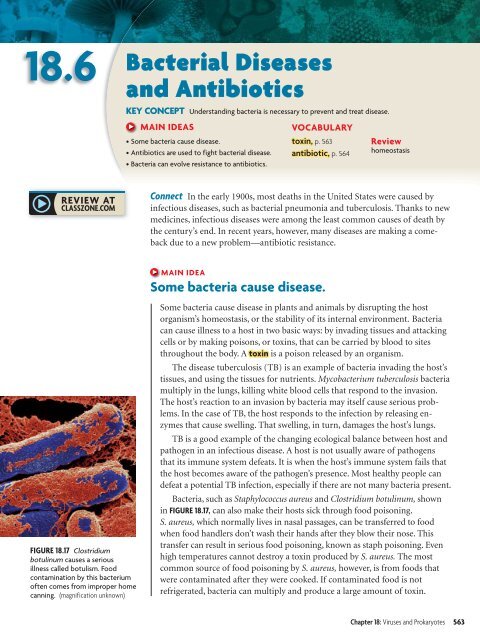18.1 Studying Viruses and Prokaryotes
18.1 Studying Viruses and Prokaryotes
18.1 Studying Viruses and Prokaryotes
You also want an ePaper? Increase the reach of your titles
YUMPU automatically turns print PDFs into web optimized ePapers that Google loves.
18.6Bacterial Diseases<strong>and</strong> AntibioticsKEY CONCEPT Underst<strong>and</strong>ing bacteria is necessary to prevent <strong>and</strong> treat disease.MAIN IDEAS• Some bacteria cause disease.• Antibiotics are used to fight bacterial disease.• Bacteria can evolve resistance to antibiotics.VOCABULARYtoxin, p. 563antibiotic, p. 564ReviewhomeostasisConnect In the early 1900s, most deaths in the United States were caused byinfectious diseases, such as bacterial pneumonia <strong>and</strong> tuberculosis. Thanks to newmedicines, infectious diseases were among the least common causes of death bythe century’s end. In recent years, however, many diseases are making a comebackdue to a new problem—antibiotic resistance.FIGURE <strong>18.1</strong>7 Clostridiumbotulinum causes a seriousillness called botulism. Foodcontamination by this bacteriumoften comes from improper homecanning. (magnification unknown)MAIN IDEASome bacteria cause disease.Some bacteria cause disease in plants <strong>and</strong> animals by disrupting the hostorganism’s homeostasis, or the stability of its internal environment. Bacteriacan cause illness to a host in two basic ways: by invading tissues <strong>and</strong> attackingcells or by making poisons, or toxins, that can be carried by blood to sitesthroughout the body. A toxin is a poison released by an organism.The disease tuberculosis (TB) is an example of bacteria invading the host’stissues, <strong>and</strong> using the tissues for nutrients. Mycobacterium tuberculosis bacteriamultiply in the lungs, killing white blood cells that respond to the invasion.The host’s reaction to an invasion by bacteria may itself cause serious problems.In the case of TB, the host responds to the infection by releasing enzymesthat cause swelling. That swelling, in turn, damages the host’s lungs.TB is a good example of the changing ecological balance between host <strong>and</strong>pathogen in an infectious disease. A host is not usually aware of pathogensthat its immune system defeats. It is when the host’s immune system fails thatthe host becomes aware of the pathogen’s presence. Most healthy people c<strong>and</strong>efeat a potential TB infection, especially if there are not many bacteria present.Bacteria, such as Staphylococcus aureus <strong>and</strong> Clostridium botulinum, shownin FIGURE <strong>18.1</strong>7, can also make their hosts sick through food poisoning.S. aureus, which normally lives in nasal passages, can be transferred to foodwhen food h<strong>and</strong>lers don’t wash their h<strong>and</strong>s after they blow their nose. Thistransfer can result in serious food poisoning, known as staph poisoning. Evenhigh temperatures cannot destroy a toxin produced by S. aureus. The mostcommon source of food poisoning by S. aureus, however, is from foods thatwere contaminated after they were cooked. If contaminated food is notrefrigerated, bacteria can multiply <strong>and</strong> produce a large amount of toxin.Chapter 18: <strong>Viruses</strong> <strong>and</strong> <strong>Prokaryotes</strong> 563
















